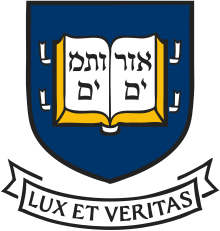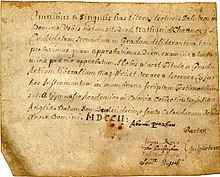From Wikipedia, the free encyclopedia
"Yale" redirects here. For other uses, see Yale (disambiguation).
| Yale University | |
|---|---|

Yale University Seal
|
|
| Latin: Universitas Yalensis | |
|
Former names
|
Collegiate School (1701–1718) Yale College (1718–1887) |
| Motto | אורים ותמים (Hebrew) (Urim V'Thummim) Lux et veritas (Latin) |
|
Motto in English
|
Light and truth |
| Established | October 9, 1701 |
| Type | Private |
| Endowment | $23.9 billion[1] |
| President | Peter Salovey[2] |
|
Academic staff
|
4,171[3] |
| Students | 12,223 |
| Undergraduates | 5,414 |
| Postgraduates | 6,809 |
| Location | New Haven, Connecticut, United States |
| Campus | Urban/College town, 1,015 acres (411 ha) including Yale Golf Course |
| Colors | Yale Blue[4] |
| Athletics | NCAA Division I FCS Ivy League |
| Nickname | Bulldogs |
| Mascot | Handsome Dan |
| Affiliations | Ivy League AAU IARU NAICU[5] |
| Website | Yale |
 |
|
Yale is organized into twelve constituent schools: the original undergraduate college, the Graduate School of Arts & Sciences, and ten professional schools. While the university is governed by the Yale Corporation, each school's faculty oversees its curriculum and degree programs. In addition to a central campus in downtown New Haven, the University owns athletic facilities in western New Haven, including the Yale Bowl, a campus in West Haven, Connecticut, and forest and nature preserves throughout New England. The university's assets include an endowment valued at $23.9 billion as of September 27, 2014, the second largest of any educational institution in the world.[1]
Yale College undergraduates follow a liberal arts curriculum with departmental majors and are organized into a system of residential colleges. Almost all faculty teach undergraduate courses, more than 2,000 of which are offered annually.[7] The Yale University Library, serving all twelve schools, holds more than 15 million volumes and is the third-largest academic library in the United States.[8][9] Besides academic studies, students compete intercollegiately as the Yale Bulldogs in the NCAA Division I Ivy League.
Yale has graduated many notable alumni, including five U.S. Presidents, 19 U.S. Supreme Court Justices, 13 living billionaires,[10] and many foreign heads of state. In addition, Yale has graduated hundreds of members of Congress and many high-level U.S. diplomats, including former U.S. Secretary of State Hillary Clinton and current Secretary of State John Kerry. Fifty-two Nobel laureates have been affiliated with the University as students, faculty, or staff, and 230 Rhodes Scholars graduated from the University.[11]
Contents
History
Charter creating Collegiate School, which became Yale College, October 9, 1701
A Front View of Yale-College and the College Chapel, Daniel Bowen, 1786.
Early history of Yale College
Origins
Yale traces its beginnings to "An Act for Liberty to Erect a Collegiate School," passed by the General Court of the Colony of Connecticut on October 9, 1701, while meeting in New Haven. The Act was an effort to create an institution to train ministers and lay leadership for Connecticut. Soon thereafter, a group of ten Congregationalist ministers: Samuel Andrew, Thomas Buckingham, Israel Chauncy, Samuel Mather, James Noyes, James Pierpont, Abraham Pierson, Noadiah Russell, Joseph Webb and Timothy Woodbridge, all alumni of Harvard, met in the study of Reverend Samuel Russell in Branford, Connecticut, to pool their books to form the school's library.[12] The group, led by James Pierpont, is now known as "The Founders".Originally known as the "Collegiate School," the institution opened in the home of its first rector, Abraham Pierson,[13] in Killingworth (now Clinton). The school moved to Saybrook, and then Wethersfield. In 1716 the college moved to New Haven, Connecticut.
First diploma awarded by Yale College, granted to Nathaniel Chauncey, 1702.
In 1718, at the behest of either Rector Samuel Andrew or the colony's Governor Gurdon Saltonstall, Cotton Mather contacted a successful businessman named Elihu Yale, who lived in Wales but had been born in Boston and whose father David had been one of the original settlers in New Haven, to ask him for financial help in constructing a new building for the college. Through the persuasion of Jeremiah Dummer, Yale, who had made a fortune through trade while living in Madras as a representative of the East India Company, donated nine bales of goods, which were sold for more than £560, a substantial sum at the time. Cotton Mather suggested that the school change its name to Yale College. Meanwhile, a Harvard graduate working in England convinced some 180 prominent intellectuals that they should donate books to Yale. The 1714 shipment of 500 books represented the best of modern English literature, science, philosophy and theology.[15] It had a profound effect on intellectuals at Yale. Undergraduate Jonathan Edwards discovered John Locke's works and developed his original theology known as the "new divinity". In 1722 the Rector and six of his friends, who had a study group to discuss the new ideas, announced that they had given up Calvinism, become Arminians, and joined the Church of England. They were ordained in England and returned to the colonies as missionaries for the Anglican faith. Thomas Clapp became president in 1745, and struggled to return the college to Calvinist orthodoxy; but he did not close the library. Other students found Deist books in the library.[16]
Old Brick Row in 1807.
Curriculum
Yale was swept up by the great intellectual movements of the period—the Great Awakening and the Enlightenment—due to the religious and scientific interests of presidents Thomas Clap and Ezra Stiles. They were both instrumental in developing the scientific curriculum at Yale, while dealing with wars, student tumults, graffiti, "irrelevance" of curricula, desperate need for endowment, and fights with the Connecticut legislature.[17]Serious American students of theology and divinity, particularly in New England, regarded Hebrew as a classical language, along with Greek and Latin, and essential for study of the Old Testament in the original words. The Reverend Ezra Stiles, president of the College from 1778 to 1795, brought with him his interest in the Hebrew language as a vehicle for studying ancient Biblical texts in their original language (as was common in other schools), requiring all freshmen to study Hebrew (in contrast to Harvard, where only upperclassmen were required to study the language) and is responsible for the Hebrew phrase אורים ותמים (Urim and Thummim) on the Yale seal. Stiles' greatest challenge occurred in July 1779 when hostile British forces occupied New Haven and threatened to raze the College. However, Yale graduate Edmund Fanning, Secretary to the British General in command of the occupation, interceded and the College was saved. Fanning later was granted an honorary degree LL.D., at 1803,[18] for his efforts.
Woolsey Hall in c. 1905
Students
As the only college in Connecticut, Yale educated the sons of the elite.[19] Offenses for which students were punished included cardplaying, tavern-going, destruction of college property, and acts of disobedience to college authorities. During the period, Harvard was distinctive for the stability and maturity of its tutor corps, while Yale had youth and zeal on its side.[20]The emphasis on classics gave rise to a number of private student societies, open only by invitation, which arose primarily as forums for discussions of modern scholarship, literature and politics. The first such organizations were debating societies: Crotonia in 1738, Linonia in 1753, and Brothers in Unity in 1768.[21]
19th century
Men leaning on the old Yale fence facing Chapel Street, c. 1874.
Until 1887, the legal name of the university was "The President and Fellows of Yale College, in New Haven." In 1887, under an act passed by the Connecticut General Assembly, Yale gained its current, and shorter, name of "Yale University."[25]






way to go,
ReplyDeleteyale!
I really appreciate your professional approach. These are pieces of very useful information that will be of great use for me in future.
ReplyDelete